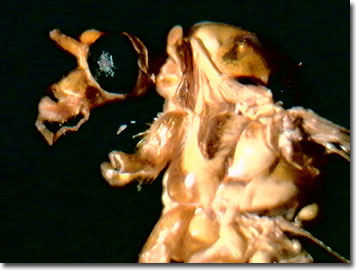Reflected Light Digital Image Gallery
Male Mosquito (Culex pipiens)
Having a worldwide distribution, the Culex genus of mosquitoes is found on every continent except Antarctica, and includes 14 species in the United States and Canada. Commonly known as the house mosquito, the blood-sucking insect feeds on warm-blooded vertebrates, including humans, birds, and horses, and is a known carrier of several serious pathogens including viral encephalitis, filiarsis, and West Nile virus.

The female mosquito is the most infamous of the two sexes because of her craving for fresh blood, while the males do not have mouthparts suitable for piercing skin, but instead feature large, bushy antennae for locating the buzz of a potential mate. The response is species-specific, so that a male Culex pipiens will only respond to a female of his kind and not one of the other 13 species. Male mosquitoes are sustained by feeding on plant juices and flower nectar. Due to their non-blood diet, the males are not the disease vectors to warm-blooded vertebrates as are their notorious mates.
While a male mosquito may live from 10 to 20 days, the female's life span ranges from as little as 3 days up to 100 days. Larval mosquitoes ("wigglers") feed on algae and organic debris in water, and are fully-grown in 2 to 14 days, depending on the species and the water temperature. The pupae ("tumblers") can swim but do not feed, and the developing eyes, legs, and wings are visible externally. In about 1 to 14 days, again temperature dependent, the adults emerge for breeding.
In general, species in the genus Culex are weak fliers and do not usually travel more than 2 miles. In contrast, the Aedes mosquitoes are known as strong fliers, flying many miles from their breeding sites, and are painful and persistent biters, even during the day. Hairlike and featherlike appendages on the wings of the mosquito are used for better flight control. There are several hairs on the wing along each vein, and the trailing edge of the wing has a fringe of long, stiff hairs. Serving the same function as an airplane's flaps, the trailing-edge stiff hairs most probably provide greater lift for the mosquito, particularly while hovering. The wing shape and beat pattern of the female mosquito create a courtship song that is species-specific for her mate. Typically, a mosquito flaps its wings about 600 times per second. Electronic reproductions and synthesized sounds mimicking the courtship songs of mosquitoes are being applied in improved sonic insect traps and automatic electronic species identification devices.
Contributing Authors
Cynthia D. Kelly, Thomas J. Fellers and Michael W. Davidson - National High Magnetic Field Laboratory, 1800 East Paul Dirac Dr., The Florida State University, Tallahassee, Florida, 32310.
BACK TO THE REFLECTED LIGHT IMAGE GALLERY
BACK TO THE DIGITAL IMAGE GALLERIES
Questions or comments? Send us an email.
© 1995-2025 by Michael W. Davidson and The Florida State University. All Rights Reserved. No images, graphics, software, scripts, or applets may be reproduced or used in any manner without permission from the copyright holders. Use of this website means you agree to all of the Legal Terms and Conditions set forth by the owners.
This website is maintained by our
Graphics & Web Programming Team
in collaboration with Optical Microscopy at the
National High Magnetic Field Laboratory.
Last Modification Friday, Nov 13, 2015 at 01:19 PM
Access Count Since September 17, 2002: 12980
Visit the website of our partner in introductory microscopy education:
|
|
